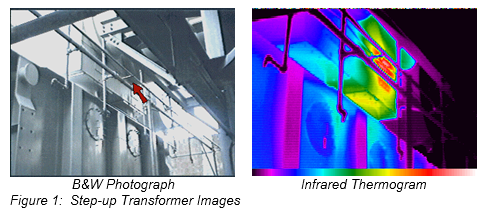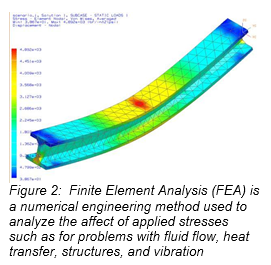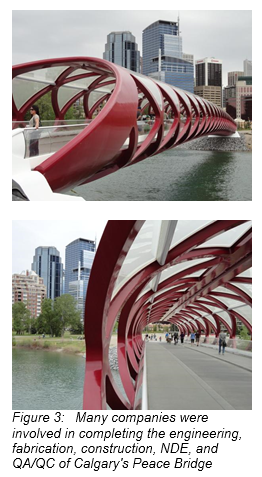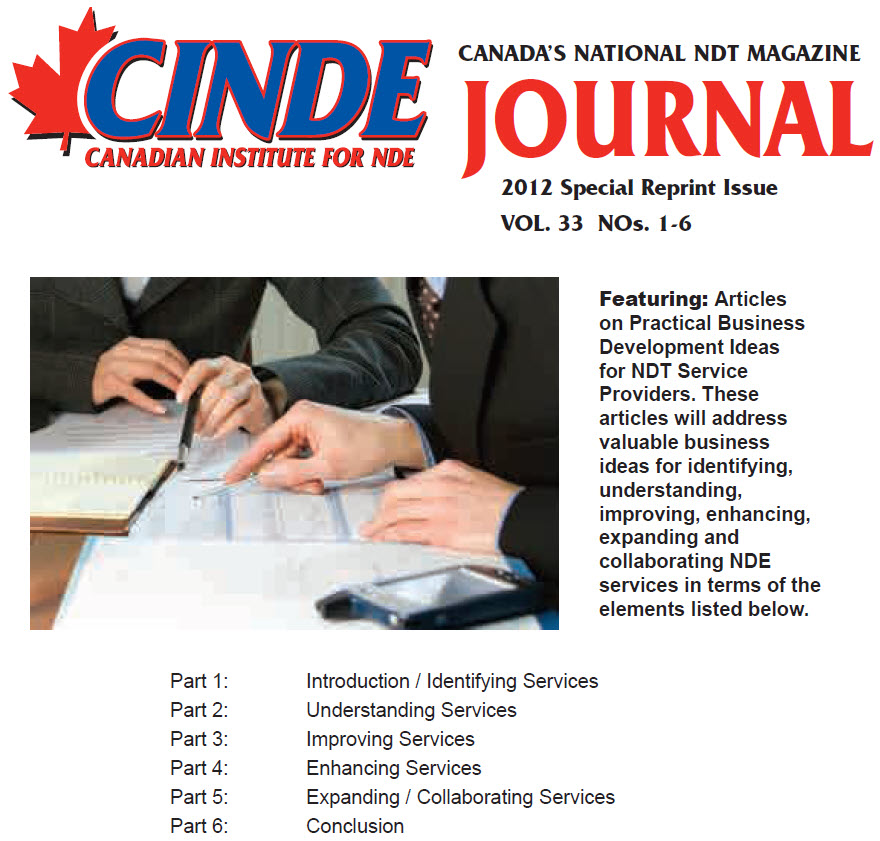Practical Business Development Ideas for NDE Service Providers – Part 5 of 6
Note: This article is the fifth in a series of six that appeared in the
Canadian Institute for NDE (CINDE) Journal throughout 2012. These articles address valuable business ideas for identifying, understanding, improving, enhancing, expanding, and collaborating NDE services in terms of the elements listed below.

- Introduction / Identifying Services
- Understanding Services
- Improving Services
- Enhancing Services
- Expanding / Collaborating Services
- Conclusion
Related: Effective Supplier Quality Surveillance (SQS).
The Fifth Element – Expanding and Collaborating Services
The purpose of expanding services is to offer your clients new or advanced NDE techniques that they might normally obtain from another company. This can create new revenue streams that also save your customer from securing other service providers (including your competition). Collaborating services is similar in that the purpose is to satisfy your customer’s needs with total turnkey solutions, but in this case, it is accomplished by subcontracting or partnering with other companies which can provide services that your company cannot.
Expanding Services
Expanding services may require a significant investment of time and resources for things such as equipment, training, and certification, to develop expertise in a new technology or technique. It may even mean hiring additional qualified staff to provide the service. Many services however, may be introduced quickly and with comparatively less effort, using your existing personnel.
Complementary technologies that could be introduced as an expanded service over and above existing core NDE services include:
- air-borne ultrasound
- balancing / alignment
- borescope
- bolt torquing
- coating inspection
- ferrite testing
- ground penetrating radar (GPR)
- hardness testing
- high speed photography / video
- infrared thermography (IRT)
- leak detection
- phased array UT
- positive material identification (PMI)
- quality auditing
- remote visual inspection (RVI)
- source surveillance
- vibration analysis
- visual inspection.
For example, infrared thermography (IRT) identifies problems unobservable to the naked eye based on minute temperature differentials. Failure modes such as the high resistance connection inside the bushing compartment of a step-up transformer are seen as pictured on the left.[1] These temperature differentials are used for assessing, maintaining and operating equipment, structures, and systems in a variety of industries. IRT Is therefore an excellent example of a new service that would complement rather than compete with your existing core NDE services.

Adding new NDE services will best complement your business when they do not directly compete for time and attention with resources already assigned to existing core NDE services. If there are periods of time when your technicians are under used because of periodic, repetitive, or seasonal business schedules, then introducing new services to increase their chargeable time is a good idea. Some people dislike doing the same old things day after day, so when introducing new technologies, you will also be engaging your employees by providing them with more training and development, to take on new technical challenges that will advance their careers.
Collaborating Services
Smaller NDE service providers may be unable to provide the same suite of services as larger companies, such as with engineering design and analysis. At the same time, larger companies might find it difficult to fully staff business units with diverse clientele and cyclical or seasonal service demands. In either case, collaboration is useful towards offering cost-effective services by working with other companies. Collaboration may also be used during a peak periods when available company resources cannot meet all required services demands.
Examples of professional services that may be offered in a collaborative manner include:

- failure analysis
- material testing
- certified coating inspection
- lifting equipment certification
- mechanical or structural engineering
- pressure equipment integrity assessments
- consulting for specialized jobs and large projects
- welding procedure development and qualification.
Being able to respond to client needs by out-sourcing or working with others allows each company to focus on their respective area of expertise, while sharing work and clients whenever opportunities arise. It is best to establish a working agreement in advance, instead of waiting to establish a new business relationship once the request for services has been made and the clock is ticking.
The relationship should establish if one company will take the primary role and the other will be a sub-contractor, or if each shall bill the client directly, and identify how resources, responsibilities, risks, and rewards will be shared. A successful partnership will require detailed proposals to be prepared that effectively describe how the service will meet the client’s needs, with the advantages of collaboration and the client’s options or risks clearly identified.
Many technical resources are available for identifying activities or assistance that may be provided to your business partners and clients. For example, the American Institute of Steel Construction standard Specification for Structural Steel Buildings[2] is available as a free download from the AISC website. It includes a new chapter N, Quality control and quality assurance, with detailed requirements for steel fabrication, erection, inspection, and NDE, including tables with activities to be completed before, during, and after welding or bolting.
As another example, the twelve part series of articles, “Understanding the Estimating Process”[3] was originally written for electrical contractors. All the steps, from knowing what and when to bid, or understanding specifications and take-offs, to preparing your proposal and cover letter, and finally submitting a bid, also apply to NDE service providers.
Does this all seem like more trouble than it is worth? A briefing paper on the positive engagement website titled “What Is Appreciative Inquiry?”[4], describes how Appreciative Inquiry (AI) was developed by David Cooperrider and his associates at Case Western Reserve University in the mid-eighties. It describes how AI was developed after his wife Nancy, an artist, told him about the “appreciative eye” – an idea that assumes that in every piece of art there is beauty.

AI is about the search for the best in people, organizations, and opportunities. It is not so much a shift in the methods and models of organizational change, but a fundamental shift to “see” and “inquire” about the strengths, possibilities, and successes.”[5]
AI applies this principle to business. In the YouTube clip titled “Appreciative Inquiry”[6] John Hayes explains how to use AI in the workplace. He states that “it is accentuating the positive rather than eliminating the negative.”
In another YouTube clip titled “What is Appreciative Inquiry?”[7] Jackie Kelm explains the 5 principles, 4-D Cycle, positive core, summit process, and the story of how AI began. She states that “what AI does is take you into a whole new realm of opportunities, instead of just fixing the problem.“
AI can be used to look for new business opportunities by identifying complementary new services to be developed and provided to both existing and new clients. Existing core services may then be used to market the new services and vice versa.
Summary
A true entrepreneur sees business opportunities that others do not and develops them into services that successfully improve client and shareholder value. The challenges presented by expanding services may be seen as creating problems that must then be solved, but let’s face it, problem-solving is a negative-focused activity. Instead, it is much better to treat the challenges of expanding your services in a positive manner, as opportunities for business improvement. Whether expanding or collaborating your services, the aim is to grow your business by servicing all your client wants and needs with a win-win approach.
Note
This article was originally published in the Canadian Institute for NDE (CINDE) Journal 2012 Vol. 33 No. 5 and in the CINDE Journal 2012 Special Reprint Issue Vol. 33 Nos. 1 – 6. http://www.cinde.ca/journal/
About the Author
Roy O. Christensen is a Welding Engineering Technologist who has over 35 years’ experience with O&G, pipeline, and other projects. He has authored countless instructions, manuals, plans, proposals, reports, specifications, and other documents that continue to drive success for many projects. He is the founder of the KT Project that saves organizations significant money and time, by providing key resources to leverage expert knowledge transfer for successful project execution.
Contact
- Roy O. Christensen
- [email protected]
- +1 403.703.2686
Figures
- Step-up Transformer Images, B&W photograph vs. thermogram, Courtesy CINDE course notes
- Finite Element Analysis http://img228.imageshack.us/img228/4259/scenario1aq6.gif
- Peace Bridge in Calgary, AB, (Two Views) by Roy O. Christensen
References
- Courtesy CINDE course notes.
- ANSI/AISC 360-10, Specification for Structural Steel Buildings, American Institute of Steel Construction, June 22, 2010 http://www.aisc.org/WorkArea/showcontent.aspx?id=26516,
- Candels. L., Understanding the Estimating Process Part 1 of 12, Electrical Construction and Maintenance, https://www.ecmweb.com/construction/estimating/article/20896250/understanding-the-estimating-process-part-1-of-12
- Cooperrider, D., What Is Appreciative Inquiry? A Positive Engagement Briefing Paper, Positive Engagement, http://www.positive-engagement.co.uk/storage/downloadable-files/What%20Is%20Appreciative%20Inquiryai.pdf
- Cooperrider, D., What Is Appreciative Inquiry?, Appreciative Inquiry Commons website, 2010 http://appreciativeinquiry.case.edu/intro/whatisai.cfm
- John H., Leeds University Business School, Appreciative Inquiry, YouTube http://www.youtube.com/watch?v=BqHeujLHPkw
- Jackie K., What is Appreciative Inquiry, YouTube

